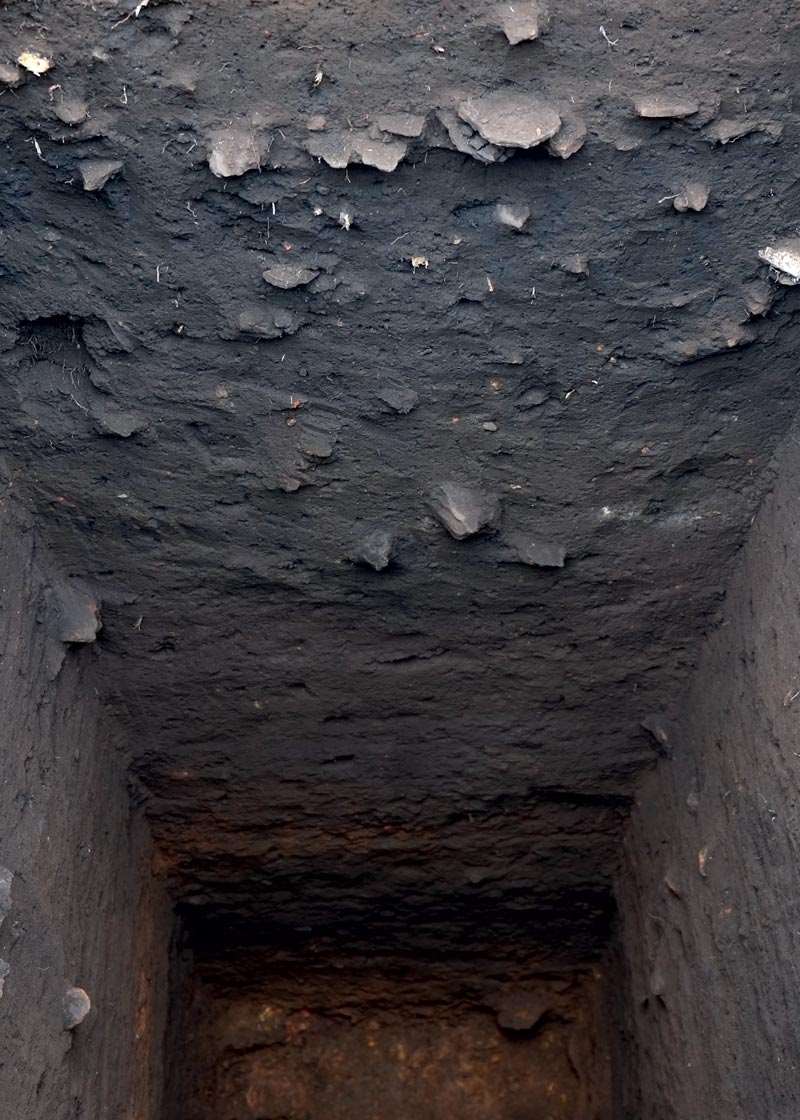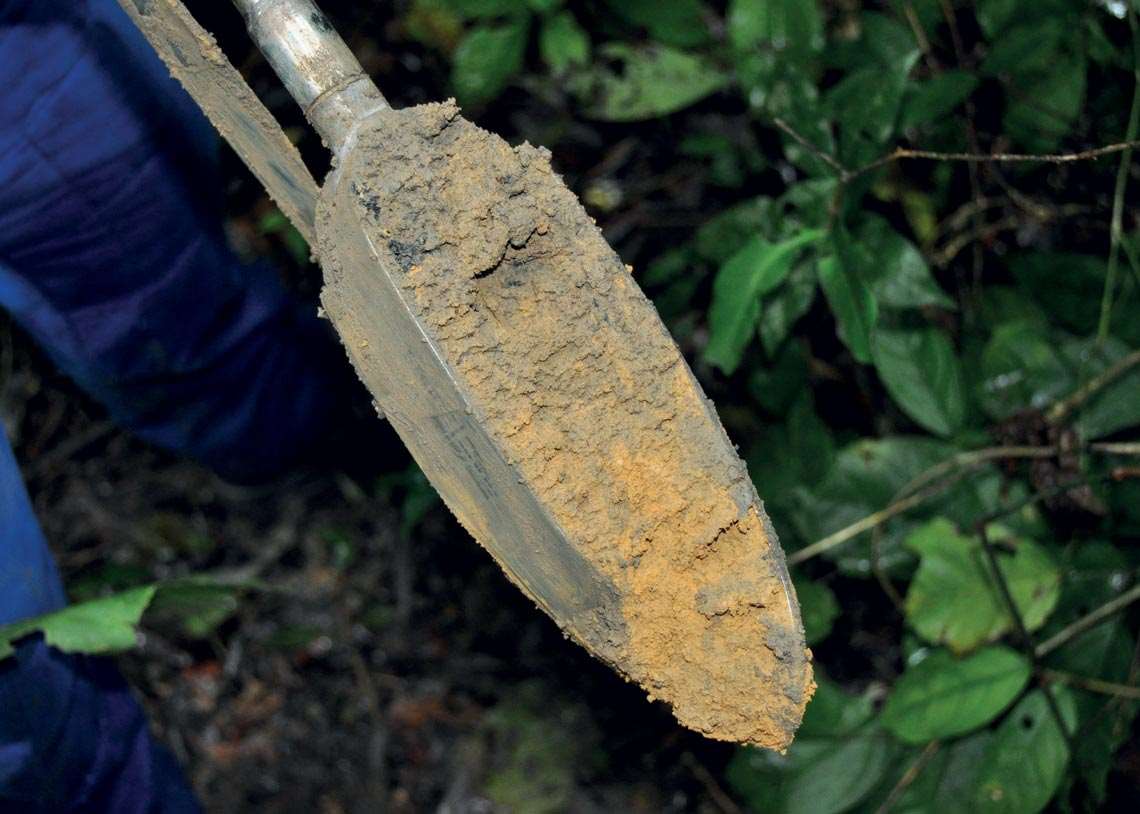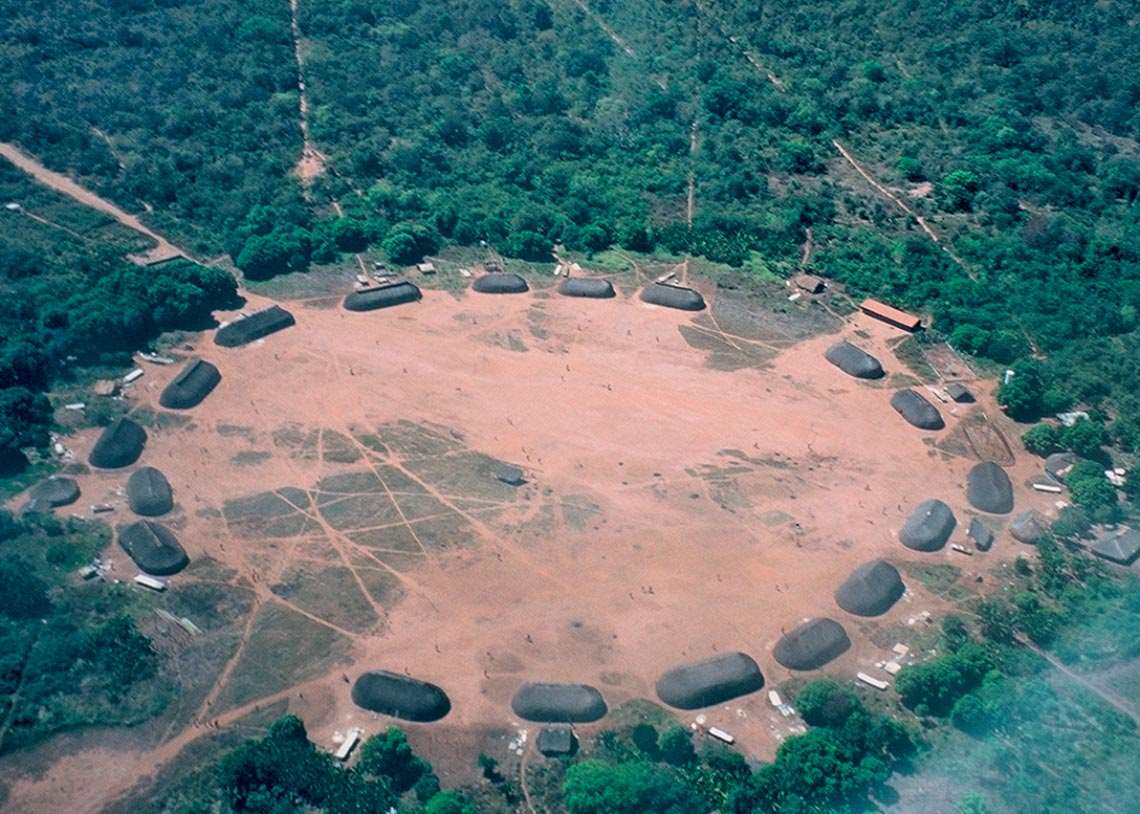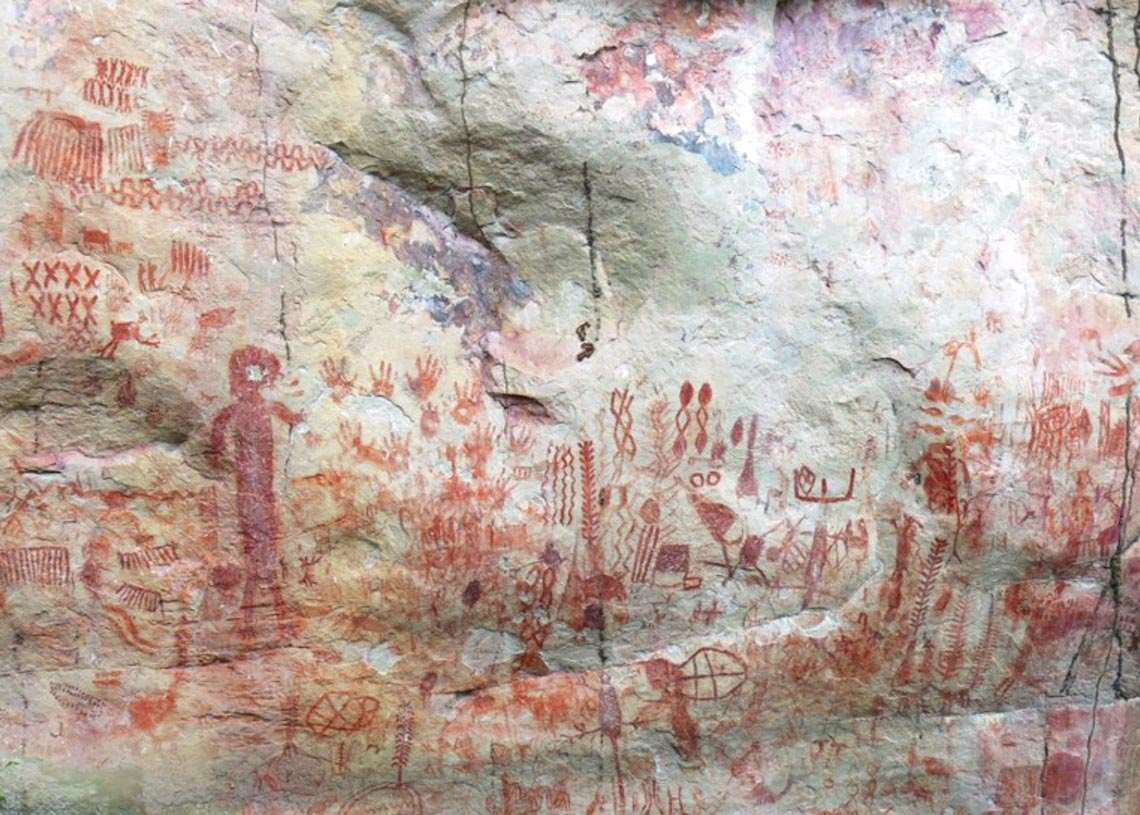A paper in the January 4 issue of Nature Communications challenges a well-established paradigm in Amazonian archeology: the anthropic origin of dark earths—layers of dark, fertile soil punctuated by pottery fragments—in the Amazon. Over many decades, archaeologists, anthropologists and soil scientists have formed a consensus that terras pretas, as they are locally known, are a legacy from long periods of occupation by pre-Colombian peoples who lived in the region between several thousand years ago and the arrival of European settlers at around 1500 AD.
According to this dominant view, the buildup of residues from food preparation, cooking fires, feces, and other organic matter at village sites successively inhabited by indigenous peoples over many decades or even centuries, led to the formation of the blackened soil. Amazonian dark earths are rich in pyrogenic carbon (also referred to as charcoal, black carbon or biochar) produced from burning organic matter. This, according to the prevailing interpretation, is a byproduct of densely populated human settlements in certain areas of the Amazon during pre-Columbian periods.
But after investigating a black-earth site known as Caldeirão, in Brazil’s northern state of Amazonas, a group of 14 researchers from Brazil, the US, and the UK have proposed an alternative hypothesis to explain the genesis of this type of soil. The authors argue that it formed naturally between 8,000 and 4,000 years ago, not through human influence but as a result of the deposition of sediments rich in chemical elements such as phosphorus, calcium, and pyrogenic carbon from other areas in the region. They make the case that ashes with a similar chemical composition to those produced by ancient mega forest fires suggest the carbon and minerals were transported to the site as sediments. “Before I started this research, I believed the anthropic origin of black earths was settled,” says the paper’s lead author, Lucas Silva, an environmental scientist at the University of Oregon. “But with the surprising data we found at Caldeirão, we were unable to explain the formation of these soils as deriving from precolonial human occupation.”
The suggestion of a non-human origin for black earths evoked a strong reaction from archaeologists, anthropologists, and even some soil scientists. Two responses to the paper, signed by respectively 45 and 49 Brazilian and international researchers, were published in the EarthArXiv and SocArXiv repositories and addressed to Nature Communications. “They investigated a single site, rehashed an old theory dating back to the 1970s, and ignored lots of the data and archaeological context surrounding black earths,” says crop scientist Wenceslau Geraldes Teixeira, from the Brazilian Agricultural Research Corporation’s (EMBRAPA) Soils chapter in Rio de Janeiro. Teixeira, who has done extensive research on Amazonian dark earths, was initially part of the team that would publish the controversial paper after nearly a decade of research, including field research and subsequent laboratory analysis and data interpretation. “I didn’t agree with the conclusions and preferred not to be listed as an author,” explains Teixeira.

Eduardo Góes Neves
Layered pre-Columbian dark-earth soils at the Teotônio site in Rondônia, punctuated by pottery shardsEduardo Góes NevesFor Eduardo Góes Neves, an archaeologist at the University of São Paulo’s Museum of Archaeology and Ethnology (MAE-USP), the conclusions from the paper may be wrong, but scientific debate about the origin of dark earths is healthy. “For sediments to have deposited the way they describe it at Caldeirão, there would have to have been large-scale flooding—in biblical proportions—in the Solimões River area. This site is on a bluff around 30 meters above the current river level,” says Góes Neves, who has previously received FAPESP grant funding to research dark earths at several Amazon sites in Teotônio, a municipality in Rondônia about 25 kilometers (km) from the state capital of Porto Velho, where he found dark earths deposits dating to 5,000 years ago.
Góes Neves also notes that some dark earths sites are far from rivers carrying sediments, such as the Açutuba site, an area of 900 hectares (ha) located 25 km north of Caldeirão. The formation of these soils, he argues, cannot be explained by the deposition of river-borne sediments. The Açutuba site sits on a 20 m plateau overlooking the Rio Negro, whose dark waters carry very little sediment, unlike the muddy waters of the Solimões. Another large area dotted by dark-earth patches in a similar geological setting can be found at the 20-ha Cipoal de Araticum archaeological site in Oriximiná, Pará, northern Brazil. This site is located between plateaus adjacent to only small headwater streams and springs, precluding significant alluvial inputs.
The authors of the new paper proposing a natural origin for the dark earths at Caldeirão argue that the climate and geomorphology in the Central Amazon region were different around 8,000 years ago from what they are today, and the riverbeds were then closer to where these areas of fertile dark soil are now found. “The landscape in the past was different than it is today,” says Rodrigo Studart Corrêa, a crop science and environmental engineering professor at the University of Brasília (UnB). Corrêa, who specializes in soil remediation, was a coauthor of the controversial paper. “We’re not trying to overthrow previous dark-earth research. But you have to keep an open mind and realize that science evolves.”
Located in the municipality of Iranduba, approximately 30 km from Manaus and the confluence of the Negro and the Solimões, the Caldeirão site is within an experimental farm run by EMBRAPA’s West Amazon chapter and is one of the most well researched dark earths sites in Brazil. The envelope of fertile, blackened soil patches covers an area of up to 23 ha. This is large compared to the average size of 1 to 2 ha for most of the hundreds of other known dark earth sites in the Amazon. Previous research has linked the formation of dark earths in this part of the Solimões River basin to ancient human settlements that were successively established in the area between 2,500 and 500 years ago.

Rodrigo Corrêa
Samples of Ultisol, one of the prevalent types of soil in the AmazonRodrigo CorrêaSilva, Corrêa, and their colleagues offer a body of evidence that they believe supports a hypothesis that the dark earths in Caldeirão began to form as a result of alluvial sedimentation—deposition of sediment that was eroded from rocks and carried to the area by floodwaters from ancient rivers—around 1,000 years before humans first settled in the region. Later, according to the authors, indigenous peoples may have benefited from and harnessed the fertility of these soils for agriculture, but they were not responsible, incidentally or otherwise, for their genesis.
The researchers analyzed 300 samples of dark earth and Ultisol—a reddish to orangish, nutrient-poor and highly acidic soil that is common in the Amazon and at the Caldeirão site. Samples were collected at 30 locations, at depths ranging from 10 centimeters to 1 meter underground. The samples provided a measure of phosphorus and calcium content in soils in the region. High concentrations of these two nutrients—two of the least abundant macronutrients in the Amazon—are generally interpreted as evidence that the soil was enriched by organic matter produced by human settlements. But the measured phosphorus and calcium levels in the dark earths at Caldeirão were more than 10 times as high as in neighboring Ultisols, and could not, according to the authors, be attributed to ancient, pre-Columbian settlements. The isotope signature—or the ratio of different variants of certain chemical elements, such as strontium and neodymium—in dark earths was also similar to that of alluvial deposition processes, another piece of evidence that Silva and Corrêa marshal to support a natural origin for this type of soil.
Dark earths are rich in carbon and nutrients and remain fertile over extended periods of time, a property that is still poorly understood by science
Radiocarbon dating of carbon samples obtained from dark earth and Ultisol profiles suggests the fertile black soil patches found at the site emerged around 7,600 years ago, predating the earliest evidence of indigenous settlements at the site. “To demonstrate a human rather than a natural origin for these dark earths, there would have to be evidence that human occupation at Caldeirão occurred far earlier and in far larger numbers than currently thought,” says Corrêa. “I could never understand how ancient human settlements in such a nutrient-poor environment as the Amazon could have given rise to dark soils that remain fertile over hundreds of years. The soil tends to become impoverished over time, especially with today’s moist climate in the North.”
Critics of the new study disagree with its inferences. Italian geomorphologist Umberto Lombardo, who is completing a postdoctoral fellowship at the University of Bern in Switzerland, and is the lead author of a response to the article by Silva, Corrêa, and colleagues, published at EarthArXiv, says the carbon sample dated at 7,600 years before present at Caldeirão—collected from a layer of Ultisol at a depth of 90 centimeters—is not a good parameter by which to establish an earlier origin for the local terras pretas. “The relevant age to understand the formation of the dark earths is that of the carbon particles found within the dark soils themselves,” he said in an interview with Pesquisa FAPESP. Lombardo is currently doing research in Llanos de Mojos, Bolivia, in a collaboration with Góes Neves. In the paper in Nature Communications, a carbon sample collected from a dark earth layer at Caldeirão was determined to be 6,300 years old.

Aikax
A Kuikuro village in the Upper Xingu, where studies have attempted to understand the relationship between present-day indigenous peoples and dark earthsAikaxBut previous dating of the same soils by other research groups suggests the first human settlements were more recent, occurring between 2,500 and 1,000 years ago. Similar ages were determined for dark earths at the Hatahara site, located 4 km from Caldeirão. “The authors of the article also failed to account for the presence of pottery shards in the dark earths at Caldeirão, an unequivocal sign of human occupation,” says archaeologist Helena Lima from the Emílio Goeldi Museum of Pará in Belém, who has previously investigated central Amazon sites during doctoral research and sites at Caldeirão around 10 years ago. “We aren’t oblivious to the pottery fragments, which are indeed a sign of human presence. But this doesn’t mean that ancient populations ‘created’ the soil,” counters Corrêa.
Surrounding the debate about the origin of dark earths—whether human as in the prevailing view, or natural as proposed in the new study in Caldeirão—is the question of how long ago the first populations of Homo sapiens settled in these parts of the Amazon, and how large those settlements were. In the last two decades, archaeological, anthropological, and paleobotany research has pushed the earliest human presence in the Amazon further and further back in time. Sites such as Caverna da Pedra Pintada (“Cave of the Painted Rock”), in Monte Alegre, Pará, show evidence of occupation by pre-Colombian peoples more than 11,000 years ago. In April last year, a group of archaeologists from the National University of Colombia and the University of Exeter published a paper in Quaternary International that dated cliff paintings in the Serranía La Lindosa, in the Colombian Amazon, at between 12,600 and 11,800 years before present. Other research on the cultivation of certain crops, such as maize and cassava, have placed early domestication in the western Amazon at between 10,000 and 5,000 years ago, potentially associated with early or partial sedentarization.

Francisco Javier Aceituno Bocanegra
A cliff painting at the Serranía La Lindosa site in the Colombian Amazon, from about 12,000 years agoFrancisco Javier Aceituno BocanegraThe size of ancient Amazon populations is a subject of much debate. The most optimistic estimates tell of precolonial indigenous populations as large as 5 to 10 million across the vast tropical forest prior to the Europeans’ arrival. “But it seems unlikely that the dark earths would have formed immediately after the most ancient settlements were established. Their occurrence is typically far more recent, rarely earlier than 2,500 years ago,” explains Góes Neves. “They must have taken hundreds or thousands of years to form, by one settlement after the other.” In the study led by Silva and Corrêa, the authors provide calculations that seem to question whether human feces and food waste produced by precolonial indigenous peoples could have created the dark earths. “For this to be true, populations in the Amazon would have had to be much larger or much more ancient,” argues Silva. A human settlement occupying an area of 50 ha, he continues, would be insufficient to explain the origin of the dark soil patches.
Defenders of the anthropic dark earth hypothesis have an explanation for this apparent discrepancy. One thousand people occupying an area 50 ha in the Amazon basin would not have spread human waste throughout its entire extent. Instead, they would have concentrated it in a small refuse midden of approximately 0.1 ha. Over time, these refuse middens would have built up over successive generations, giving rise to the highly fertile, blackened soil. This is the most widely accepted explanation for the origin of dark earths. But much like the disputed hypothesis of a natural origin for these Amazon soils, the dominant theory is not without its controversies. It remains to be shown, for example, whether ancient indigenous peoples intentionally produced the dark earths or whether they formed incidentally from a buildup of human refuse, without any planning. In the Xingu Indigenous Park in northern Mato Grosso, archaeologist Morgan Schmidt from the Massachusetts Institute of Technology (MIT) has studied the relationship between the area’s current occupants, the Kuikuro, and the dark earths formed in the past, and their contemporary practices. “Our data shows that dark earths are still being produced intentionally today by indigenous villages in the Upper Xingu,” says Schmidt, who will soon submit an article for publication on this very subject.
Scientific articles
SILVA, L. C. R. et al. A new hypothesis for the origin of Amazonian Dark Earths. Nature Communications. Jan. 4, 2021.
LOMBARDO, U. et al. Evidence confirms an anthropic origin of Amazonian Dark Earths. EarthArXiv (preprint). Jan. 22, 2021.
SCHMIDT. M. J. et al. Archaeology and ethnography demonstrate a human origin for Amazonian Dark Earths. SocArXiv (preprint). Feb. 14, 2021


